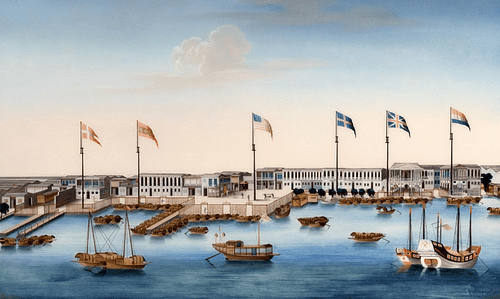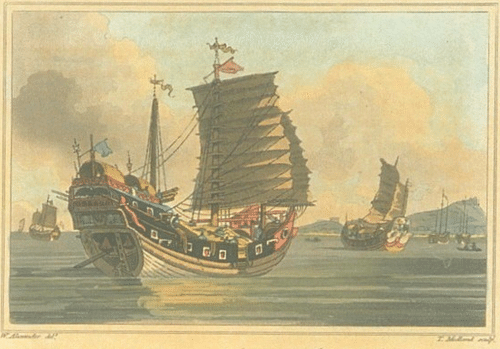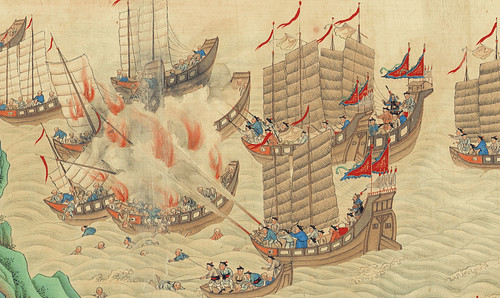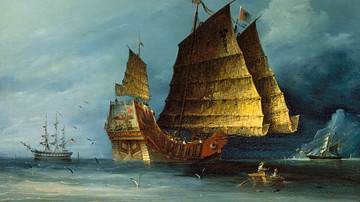
Zheng Yi Sao (aka Ching Shih, Cheng I Sao, Ching Yih Saou or Mrs Cheng, d. 1844) was the chief of a massive pirate confederation which plundered the South China Sea in the early 19th century. She inherited the role from her late husband, Zheng Yi (1765-1807), expanding the pirate fleet and defeating three Chinese flotillas in the process.
The imperial Chinese, British, and Portuguese navies could not bring Zheng Yi Sao to justice, and it was only when she herself choose to accept a pardon that the great pirate confederation was disbanded. Over three years, she had beaten all comers but also caused terror along the coast of southern China where thousands of civilians were robbed, murdered, and sold into slavery.
Zheng Yi's Pirate Confederation
Zheng Yi (also known as Ching I), was the leader of a large pirate confederation, and he caused terror in the South China Sea. Over a period of just two years, Zheng built up this force to around 600 ships and up to 40,000 men. They were divided into six divisions, each led by an independent commander who operated in an agreed area of the South China Sea. Each of the six fleets was easily identified by their ships carrying a specific coloured flag. Zheng Yi himself commanded the largest of these, the 200-ship Red Flag Fleet. The pirates attacked ships from Hong Kong to Vietnam, including foreign ships and large merchant vessels carrying precious goods to and from China and Malaysia. One particular pirate hotspot was around Canton (modern Guangzhou) and the islands of the Canton River Delta – so much so, European sailors called this place, and the pirates who haunted it, Ladrones (meaning thieves or brigands).
Captured cargoes included precious goods like gold, silver, rolls of silk, spices, Chinese porcelain, tea, and cotton. These goods were then sold on to merchants on the coast. In the case of foreign ships, captured mariners were often ransomed. Coastal towns were also attacked, either to loot them of provisions or to encourage the payment of protection money, a strategy also applied to captains of merchant vessels who were required to purchase a pass or risk attack from any ship in the confederation. On occasion, even coastal fortifications fell to the pirates. Zheng Yi was remarkably successful, and not even raids by the Chinese authorities had very much impact on his operations. Then disaster struck, and the pirate chief was killed in November 1807, either in action or in a typhoon. The other five pirate captains had to decide on a successor, and they chose Zheng Yi's widow, Zheng Yi Sao. Although we know a great deal about her exploits from here on in, there are no reliable descriptions of either her character or physical appearance. Zheng Yi Sao must be judged by her deeds alone.
Chang Pao
Zheng Yi Sao had worked as a prostitute in Canton before marrying in 1801. It was not uncommon for Chinese women to be mariners, captains, or involved in piracy, and clearly, her rival pirate commanders must have thought her very capable. She had one serious rival or ally, depending on how things panned out. Chang Pao (aka Cheung Po Tsai, c. 1786-1822) was a captain of one of the Red Flag ships, and he had been a protege of Zheng Yi's. The two men had also been lovers, a not unusual arrangement between junior and senior Chinese pirates. Chang Pao became Zheng Yi Sao's lover and, promoted to lead the Red Flag Fleet, her second in command. Like some captains during the Golden Age of Piracy in the Caribbean, Chang Pao was partial to making a fashion statement, and he famously sported a black turban and long purple cloak.
The Scourge of the South China Sea
The pirate fleet had grown with each new raid in Zheng Yi's final year in charge, and his widow continued the trend so that the six fleets combined numbered around 800 large ships by 1807. A good number of these ships were junks. The junk had been the mainstay of Chinese waters for centuries. They could carry up to 800 tons of cargo and bristle with 40 cannons. Being without a keel and with a retractable rudder, junks could enter shallow waters and surprise a target vessel at anchor. Junks could carry small boats, too, and these, carrying 20 men and a number of swivel cannons, were used to approach a ship undetected. The number of pirates grew correspondingly, too, and Zheng Yi Sao's confederation may have numbered over 70,000 men.
Such was the combined firepower of the Chinese pirates, they could even take on small naval fleets of the European powers. One member of the British Royal Navy made the following remarks after HMS Phaeton and HMS Bellona tried to unsuccessfully warn off the pirates:
About 60 or 70 sail of Ladrones passed in the most impudent manner within range of the guns…Determined to punish the presumption of these pirates…the frigate opened a smart fire on them which was received by the Ladrones with the utmost coolness and indifference, and without even returning a shot.
(quoted in Cordingly & Falconer, 107)
As with piracy in the Caribbean, those mariners sensible enough to surrender without a fight were usually left alone to watch only the cargo be stolen. Those who put up any resistance faced torture or execution if captured. European mariners fared slightly better since they could be ransomed, but this was not a quick process, and so many were kept in cramped and filthy conditions for months. One such sailor, Richard Glasspoole, fourth officer on the captured Marquis of Ely, described how he was kept in the rat-infested hold of a ship of Zheng Yi Sao's pirates for four months, during which time he was obliged to survive on caterpillars and rice.
Officer Glasspoole also describes the operations of the pirates. Those Chinese captured were given the stark choice of joining the pirates or being flogged to death. Captured European mariners were forced to assist in attacks on villages, where the pirates collected the heads of their victims, tying pairs together using the pigtails and wearing them around their necks as gruesome trophies. Glasspoole's gunnery skills meant that he was used by Zheng Yi Sao to operate cannons. The Englishman seems to have become a favourite of the pirate chief as, believing it would ward off any chances of injury, she was said to have sprinkled garlic water over him before each battle.
Defeating the Chinese Navy
Zheng Yi Sao continued to concentrate on the Canton area, still the major trade hub of that coast, and she plundered with success for another three years. In July 1808 and July 1809, she twice obliterated Chinese naval fleets guarding the river delta between Portuguese Macao and Canton. The first battle had taken 16 hours, and after the disaster, the Chinese admiral committed suicide. The second attack required more imagination since both fleets were becalmed. Zheng Yi Sao ordered her men to swim to the Chinese ships and board them, which they did. Coastal towns were then torched, as happened to Sanshan in August where 80 villagers were executed, and their heads were hung in a large tree on the coast as a warning to others. In September, 1,000 civilians were killed on Tao-chiao Island. In total, over 10,000 civilians were killed in a sustained campaign of terror that saw the pirates get to within just 16 miles (25 km) of Canton itself. Even powerfully-armed European warships were taken on, such as two Portuguese ships protecting Macao in September 1809.
Rules & Punishments
Zheng Yi Sao's success was in part due to her management skills. She not only balanced rival and volatile pirate captains and crews but kept meticulous records and imposed a set of regulations on the pirates in her fleets, some of which were a different approach from her late husband's. These rules included:
- A pirate may not go ashore without permission. A first punishment for breaking this rule was to have one's ears slit. The second punishment was execution.
- Captured goods are to be registered before being shared out.
- An individual ship that captures a cargo may keep one-fifth, the rest is to be added to the general prize-fund of the whole fleet.
- No abuse of women, captured or otherwise, is permitted without permission from the quartermaster. A pirate may buy a captured woman for his wife for $40 (if she is not to be held for ransom).
- Townsfolk must be paid for their provisions (clearly not always applied).
The historian D. Cordingly gives the following summary of punishments for those pirates who did not follow the rules:
The punishment for disobeying an order or for stealing from the common treasure or public fund was death by beheading. For deserting or going absent without leave a man would have his ears cut off. For concealing or holding back plundered goods the offender would be whipped. If the offense was repeated, he would suffer death. The rules were equally strict over women prisoners. The rape of a female captive was punishable by death. If it was found that the woman had agreed to have sex with her captor, the man was beheaded and the woman was thrown overboard with a weight attached to her legs. (76)
Pardon & Later Life
If anything, Zheng Yi Sao became a victim of her own success. Piracy was so widespread in the area and the disruption to regional trade so great that even large cities were struggling to feed their populations. Finally, the Chinese authorities pushed themselves to a greater effort in stamping out the pirates.

There were also difficulties in keeping the pirate confederation together. The leader of the 100-ship Black Flag Fleet, for example, one Kuo P'o-Tai (aka Kuo Hsüeh-hsien), was jealous of Chang Pao's elevated role; he may even have been jealous of his monopoly of Zheng Yi Sao's affections. Kuo P'o-Tai once refused to help his rival's Red Flag Fleet in a battle against a combined Chinese and Portuguese fleet at Lantao (near Hong Kong) in November 1809. In retaliation for his disloyalty, Chang Pao attacked Kuo P'o-Tai's fleet in December. Kuo P'o-Tai won this bitter battle but, perhaps realising his days within the confederation were numbered, he surrendered himself to the authorities in January 1810, gaining both a pardon and employment as a pirate-hunter. With a large part of her fleet now destroyed or disbanded, in April 1810 Zheng Yi Sao decided to call it a day, too.
Zheng Yi Sao gave up piracy in style, sailing her entire fleet of 260 junks, all flags flying, into Canton harbour, marching up to the authorities, and demanding a pardon on 18 April 1810. She gained her pardon with favourable terms: the pirates could keep their plunder but had to give up most of their ships and weapons. Chang Pao also did well, he was permitted to keep 20 of his junks and was made a naval mandarin. Many of the pirate crews were recruited into the Imperial Chinese Navy if they so wished where they were tasked with stamping out piracy in the region, an endeavour assisted by the British Royal Navy after the formal establishment of a British colony at Hong Kong in 1841. The temptations of the sea, though, meant that some pirates, like Chui-Apoo (d. 1851) and Shap-ng-Tsai (active 1840s to 1850s), continued to plague the South China Seas for a good while yet.
Zheng Yi Sao married Chang Pao, and they settled in Canton before moving to Fukien; they had one son together. The former pirate chief eventually returned to Canton and spent the rest of her career managing a large and successful smuggling racket fronted by a gambling house. She died, aged 69, in 1844. Zheng Yi Sao's legend meanwhile only grew, and she has inspired many fictional female pirates ever since, perhaps most recently with the character of Mistress Ching in the 2007 Disney film Pirates of the Caribbean: At World’s End.








